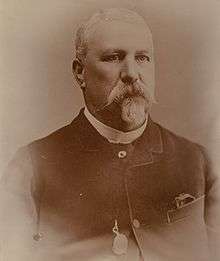William John Peterswald
| William John Peterswald | |
|---|---|
 | |
| Born |
William John von Peterswald 28 November 1829 Jamaica, West Indies |
| Died | 28 August 1896 (aged 66) |
| Resting place | North Road Cemetery |
| Education | Edinburgh Academy, Elizabeth College, Guernsey |
| Occupation | Chief Commissioner of Police |
| Years active | 1882–1896 |
| Employer | South Australia Police |
| Organization | Colony of South Australia |
| Title | Commissioner of Police |
| Partner(s) | Emily Mary de St Croix |
William John Peterswald was Commissioner of Police of the Colony of South Australia 1882–1896.
Origins
William John Von Peterswald was born 28 November 1829 at Jamaica, West Indies and educated at the Edinburgh Academy, Scotland and Elizabeth College, Guernsey. He commanded the 1st Rifle Company attached to the Channel Islands Militia and arrived in South Australia on the Charlotte Jane in May 1853 [1] He then commenced farming at Munno Para, with limited success.
Police career
In 1862 he joined the South Australia Police as Inspector of Metropolitan Police and resigned in 1866 to become Warden of the Goldfields. He rejoined the police in 1874 and rose to the rank of Superintendent. He was appointed Acting Commissioner of Police in 1881 and then Commissioner of Police in 1882, succeeding George Hamilton, in which position he served until his death in August 1896.[2][3][4]
Legacy
For 15 years Peterswald steadily guided the police through ever-increasing responsibilities despite often having a constrained budget.
As a particular challenge, the police under his leadership established law and order between both European settlers/pastoralists and indigenous communities as the frontier of modernity expanded throughout the vast distances of Central Australia and the Northern Territory. In the latter case, the change was so rapid that in 1884 Peterswald established a branch of native police there.
The difficult conditions necessitated more modern equipment. In the early 1880s Peterswald was responsible for initiating the re-arming of the Police Force. In early 1881 the Police were issued with 200 of the new Martini-Henry rifles in .455/.577 calibre and long-pattern bayonets, as used by the Volunteer Militia Forces. Peterswald also recommended that the Mounted Police be issued with the large New Model No. 3 Smith & Wesson revolver in .44 calibre.
Public economic distress and unemployment during the 1880s and early 1890s presented the police with their first experiences of serious industrial unrest, all of which Peterswald handled with firm impartiality. To improve police esprit de corps he introduced revised uniform patterns and in 1884 encouraged the formation of a police band.[5]
He also introduced uniformity in the colour of police horses, exclusively selecting the impressive greys for metropolitan duty. This strain, despite being somewhat unsuitable for the outback, was later extended to many rural police horses.
For years Peterswald suffered from diabetes, which was the principal cause of his death in 1896. [6] He was accorded with a state funeral, the procession being watched by large crowds of onlookers.[7] In later years Peterswald lived at "St. Heliers", on the corner of Ward and Jeffcott streets, North Adelaide. His wife, Emily Mary Peterswald, who was a daughter of Charles de Ste. Croix, Greffier of the Island of Jersey, died 19 April 1916 at her residence on Buxton Street, North Adelaide, also named "St Heliers".[8]
References
- ↑ Parson, Ronald. "South Australian Migrant Shipping (1836-1860)".
- ↑ "The Late Commissioner Peterswald". South Australian Register. Adelaide. 31 August 1896. p. 4. Retrieved 13 November 2013 – via National Library of Australia.
- ↑ "The Late Commissioner of Police". South Australian Register. Adelaide. 3 September 1896. p. 6. Retrieved 13 November 2013 – via National Library of Australia.
- ↑ "The Late Commissioner of Police". The Advertiser. Adelaide. 3 September 1896. p. 5. Retrieved 13 November 2013 – via National Library of Australia.
- ↑ Clyne, Robert | Colonial Blue : A History of the South Australian Police Force, 1836–1916. (Wakefield Press, 1987), p. 206.
- ↑ "Death of Commissioner Peteswald". The Chronicle. 39, (1, 985). South Australia. 5 September 1896. p. 20. Retrieved 17 April 2016 – via National Library of Australia.
- ↑ "The Funeral". The Chronicle. 39, (1, 985). South Australia. 5 September 1896. p. 21. Retrieved 17 April 2016 – via National Library of Australia.
- ↑ "Concerning People". The Register (Adelaide). LXXXI, (21, 668). South Australia. 20 April 1916. p. 4. Retrieved 7 August 2018 – via National Library of Australia.